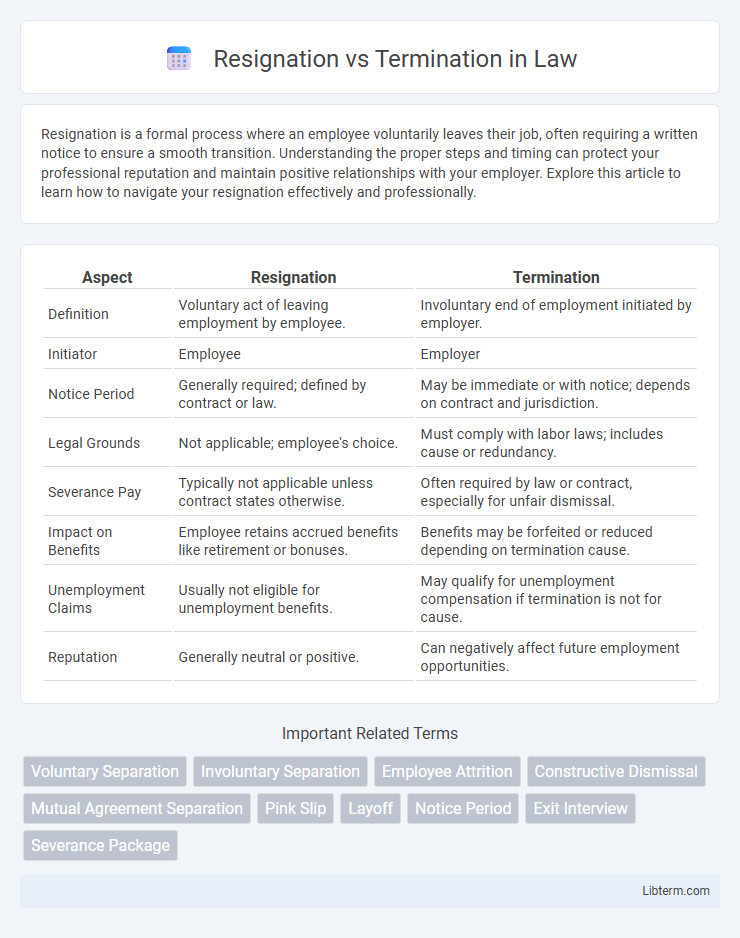Resignation is a formal process where an employee voluntarily leaves their job, often requiring a written notice to ensure a smooth transition. Understanding the proper steps and timing can protect your professional reputation and maintain positive relationships with your employer. Explore this article to learn how to navigate your resignation effectively and professionally.
Table of Comparison
| Aspect | Resignation | Termination |
|---|---|---|
| Definition | Voluntary act of leaving employment by employee. | Involuntary end of employment initiated by employer. |
| Initiator | Employee | Employer |
| Notice Period | Generally required; defined by contract or law. | May be immediate or with notice; depends on contract and jurisdiction. |
| Legal Grounds | Not applicable; employee's choice. | Must comply with labor laws; includes cause or redundancy. |
| Severance Pay | Typically not applicable unless contract states otherwise. | Often required by law or contract, especially for unfair dismissal. |
| Impact on Benefits | Employee retains accrued benefits like retirement or bonuses. | Benefits may be forfeited or reduced depending on termination cause. |
| Unemployment Claims | Usually not eligible for unemployment benefits. | May qualify for unemployment compensation if termination is not for cause. |
| Reputation | Generally neutral or positive. | Can negatively affect future employment opportunities. |
Introduction: Understanding Resignation and Termination
Resignation occurs when an employee voluntarily decides to leave their position, submitting a formal notice to their employer. Termination refers to the employer's decision to end the employment relationship, which can be due to performance issues, misconduct, or organizational restructuring. Understanding the fundamental differences between resignation and termination is essential for navigating employment rights, final pay, and future job prospects.
Defining Resignation: Voluntary Employee Departure
Resignation represents a voluntary employee departure initiated by the individual, signaling their decision to leave the organization on their own terms. This self-initiated exit contrasts with termination, where the employer enforces the separation due to performance issues, policy violations, or organizational restructuring. Understanding the nuances of resignation helps clarify employee intent and affects subsequent processes such as exit interviews, final pay, and rehire eligibility.
What is Termination? Involuntary Job Endings Explained
Termination refers to the involuntary ending of an employee's job by the employer, often due to performance issues, misconduct, or organizational restructuring. This process can include layoffs, dismissals, or firings, and typically involves formal documentation and adherence to company policies or legal regulations. Understanding the distinctions between termination and resignation helps clarify employee rights and employer responsibilities in workforce management.
Key Differences Between Resignation and Termination
Resignation occurs when an employee voluntarily leaves a job, while termination is an employer-initiated end to the employment relationship. Resignation often involves notice periods and exit procedures, whereas termination might be immediate or follow disciplinary actions. Understanding these distinctions is crucial for legal compliance, severance eligibility, and future employment references.
Legal Implications: Rights and Obligations
Resignation involves an employee voluntarily ending their employment, typically requiring adherence to notice periods as defined by employment contracts or labor laws, which protects both parties' interests. Termination, whether initiated by the employer or due to cause, triggers specific legal obligations such as severance pay, unemployment benefits eligibility, and potential wrongful termination claims under labor regulations. Both scenarios demand strict compliance with local employment laws to safeguard employee rights and avoid legal disputes related to breach of contract or unfair dismissal.
Impact on Employee Benefits and Compensation
Resignation typically allows employees to retain accrued benefits such as unused vacation pay and pension contributions, whereas termination may result in the loss of certain benefits depending on the cause and company policies. Severance packages and unemployment insurance eligibility are more commonly available to terminated employees, especially in cases of layoffs or downsizing. Health insurance coverage under COBRA can extend for both resignation and termination, but the financial responsibility often shifts more significantly during termination scenarios.
Effects on Future Employment Opportunities
Resignation often allows employees to maintain a positive professional reputation, which can enhance future employment opportunities by demonstrating voluntary departure and professional integrity. Termination, particularly for cause, may raise red flags for potential employers, potentially limiting job prospects and necessitating clear explanations in interviews. Employers typically view resignations more favorably, as they suggest mutual agreement to end the relationship, while termination can be perceived as a result of performance or conduct issues.
Employer Responsibilities in Each Scenario
Employers must ensure proper documentation and adherence to legal requirements during both resignation and termination processes. In resignation cases, they are responsible for confirming the employee's final workday, processing outstanding wages, and providing necessary exit paperwork, including benefits and tax forms. During termination, employers must conduct thorough investigations, follow company policies, deliver termination notices, and comply with labor laws to avoid potential legal disputes.
Emotional and Professional Consequences
Resignation often allows individuals to maintain a sense of control and preserve professional relationships, reducing negative emotional impacts such as stress and anxiety, while termination can lead to feelings of rejection, decreased self-esteem, and potential difficulties securing future employment. Professionally, voluntary resignation enables a smoother transition with possible positive references, whereas termination might result in a damaged reputation and gaps in work history. Understanding these emotional and professional consequences is crucial for managing career trajectories and personal well-being.
Best Practices for Navigating Job Separation
Clarifying the differences between resignation and termination is essential for managing job separations effectively, ensuring compliance with labor laws and protecting professional reputation. Best practices include documenting all communications, understanding severance and final paycheck regulations, and preparing exit interviews to facilitate transparent dialogue. Maintaining professionalism during the transition supports future networking opportunities and preserves positive references.
Resignation Infographic

 libterm.com
libterm.com